Since January 2020, The Local's team of two full-time journalists has published hundreds of articles on the coronavirus, heard from hundreds of our readers about your questions and experiences, and put questions to Swedish government ministers and officials. Thank you to our readers and especially our paying members for your support of our work during the pandemic.
January 2020
January 31st: Sweden reports its first confirmed case of the novel coronavirus, Covid-19. A woman in her 20s in Jönköping, who had recently visited Wuhan in China, is isolated in hospital for treatment.
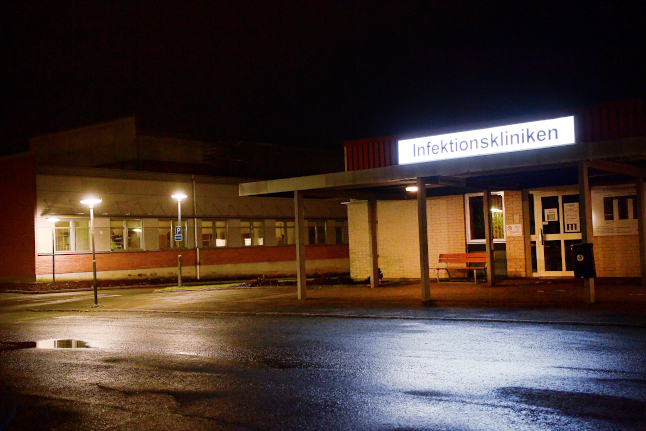
The infectious disease clinic in Jönköping. Photo: Mikael Fritzon/TT
February 2020
February 1st: Sweden's government labels the coronavirus as a 'socially dangerous disease'. This allows the government to take certain actions under the Communicable Diseases Act, such as requiring people to be tested or putting entire buildings or areas under quarantine if judged necessary.

A tent for testing people for coronavirus outside Gothenburg's Sahlgrenska Hospital. Photo: Adam Ihse/TT
March 2020: 386 deaths
March 2nd: People in the Stockholm region return to work and school after the winter half-term break, spent by many in the Alps where the virus is spreading quickly. The timing of this break, a week after the other large city regions, and the national guidelines that people returning to Sweden after international travel do not need to get tested or isolate themselves, has been cited as one of the main reasons the capital city was hit so hard by the first wave.
The Foreign Ministry advises against travel to Iran, and on March 6th will add some northern Italian regions and parts of South Korea to that list.
March 10th: The Public Health Agency raises its assessment of the risk of the coronavirus spreading in Sweden to 'very high', after raising it from 'low' to 'moderate' on March 2nd.
March 11th: Sweden reports its first confirmed death from the coronavirus, on the same day the World Health Organisation classifies the global outbreak as a pandemic.
March 12th: Sweden bans public gatherings of more than 500 people as all of Sweden's 21 regions have now confirmed coronavirus cases.
The Public Health Agency updates its guidelines to urge anyone with symptoms of the coronavirus or a cold (for example a fever and cough), regardless of whether or not you have been travelling, to stay at home and limit social contact until you have been symptom-free for at least two days. But in Stockholm, which has most cases, only elderly people or those needing hospital care will be offered tests due to limited testing capacity.
March 14th: The Foreign Ministry advises against all non-essential travel overseas, due to the outbreak and increasing travel restrictions. This is not legally binding and Sweden does not introduce restrictions for travellers returning from overseas until the end of the year.
March 16th: The Public Health Agency recommends that all employers ensure everyone who can work from home does so. It also recommends that over-70s self-isolate and avoid all environments where they could come into close contact with others including supermarkets and grocery stores, encouraging them to use home delivery services or ask a friend or neighbour to shop for them.
The government announces plans for a 300 billion kronor crisis package to support affected businesses and individuals.
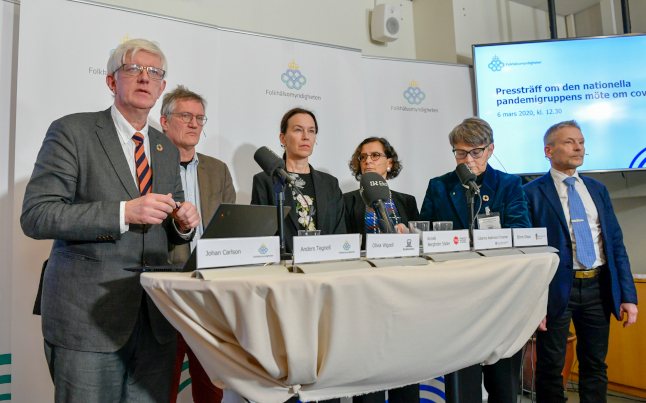
Swedish officials at a press conference about the coronavirus situation on March 6th. Photo: Adam Ihse/TT
March 17th: The Public Health Agency recommends that upper secondary schools, universities and other adult education institutions move to distance learning.
The same day, Sweden adopts a ban on travel from non-EU countries following an EU decision. Initially this is set to last 30 days, but will ultimately last into 2021, with some exceptions for Swedish or EU citizens as well as certain countries.
March 18th: Sweden's Public Health Agency publishes its coronavirus information in a variety of languages following criticism that this is lacking.
March 22nd: Prime Minister Stefan Löfven addresses the nation on TV. In a six-minute speech, he urges everyone in Sweden to take responsibility and follow the new recommendations closely, as well as showing solidarity by helping elderly neighbours shop or buying takeaway lunches to support local restaurants.
March 27th: The upper limit on public events is lowered to 50 people.
March 31st: The government bans visits to care homes for the elderly across the country, though some individual municipalities or homes have already taken measures to stop visits.

Prime Minister Stefan Löfven addresses the nation on TV. Photo: Jessica Gow/TT
April 2020: 2,569 reported deaths
April 5th: King Carl XVI Gustaf gives a televised speech to the nation from the palace where he is isolating, as an over-70-year-old. He urges Swedes to follow the restrictions and take comfort in the fact they are not alone: “There is still a great deal of uncertainty. But one thing is certain: we will remember these times and look back on them. Did I think about other people? Or did I put myself first? We will have to live with the choices we make today, for a long time to come. They will impact many.”
April 10th: Healthcare workers in Stockholm are offered coronavirus testing, but this is not yet rolled out to workers in elderly care homes. These have been so hard hit that the Health Inspectorate has begun an investigation into their handling of the pandemic.
April 8th and 15th: Public Health Agency data will later show these two days were the deadliest of the first wave of the virus, with 115 deaths taking place on each of these dates.
April 18th: A new temporary pandemic law, first proposed by the government ten days earlier, comes into effect. It gives the government special powers to take faster decisions to limit the spread of infection, such as closing any or all Swedish gyms, shops or restaurants. It will expire in July without ever being used, with the government saying changes pushed through by the opposition made it impractical.

Signs in multiple languages warning Stockholmers of the coronavirus. Photo: Fredrik Sandberg/TT
May: 1,712 reported deaths
May 29th: The government announces that upper secondary schools and universities may revert to teaching in person.
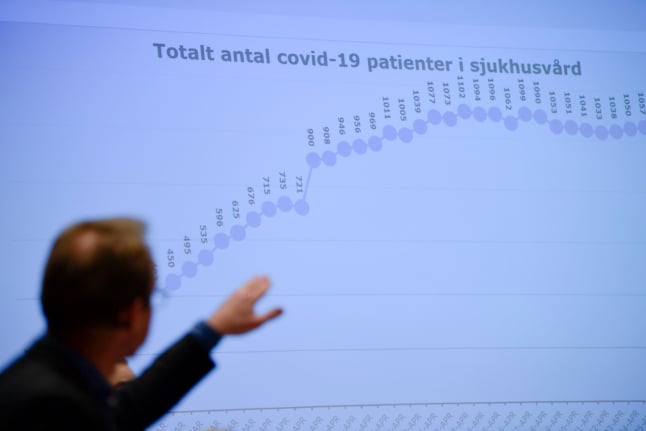
Stockholm's healthcare director Björn Eriksson shows a press conference in early May how many Covid-19 patients are being treated in the region's hospitals. Photo: Anders Wiklund/TT
June: 830 reported deaths
June 4th: The Public Health Agency announces an overhaul of testing, meaning tests will be offered to anyone with symptoms who is referred for a test by a doctor, regardless of the severity of their symptoms, and contact tracing will be resumed. These changes do not come into effect immediately in all regions.
June 13th: Ahead of the summer, the Public Health Agency says that domestic travel can take place with no restrictions, but everyone must continue to follow recommendations around social distancing and avoiding public transport if possible.
June 30th: The government puts together an independent coronavirus commission to evaluate measures taken during the crisis.

A high school graduation ceremony adapted to social distancing rules. Photo: Jessica Gow/TT
July: 234 reported deaths
July 7th: The Health and Welfare Inspectorate states that it has found 'serious failures' in 91 care homes, which will be investigated further.
July 21st: The Public Health Agency presents three scenarios based on models for the probable spread of infection for the rest of the year: a continued decrease; moderate spread of infection in clusters; and widespread spread of infection. The agency's assessment is that an uneven spread with clusters of outbreaks is most likely.
July 30th: The national recommendation to work from home is extended until the end of the year.

A protester outside the Public Health Agency's office, urging authorities to 'do more, save lives'. Photo: Ali Lorestani/TT
August: 71 reported deaths
August 24th: People who are at high risk of serious illness from the coronavirus can claim for compensation if the pandemic meant they missed work.
August 27th: The Public Health Agency suggests that the government raise the limit of attendees allowed at public events to 500.
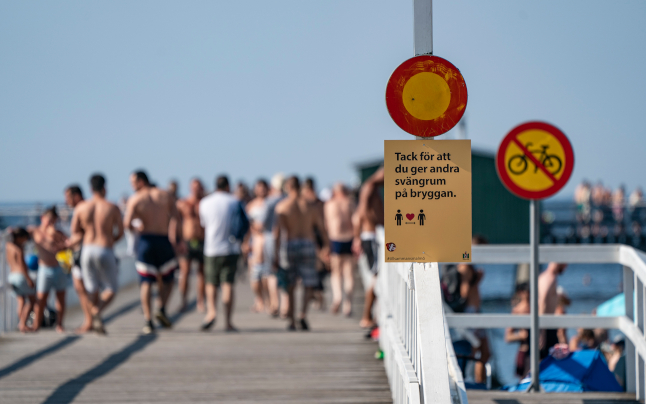
A sign urging people to keep their distance in Malmö. Photo: Johan Nilsson/TT
September: 51 reported deaths
September 1st: The Public Health Agency updates the advice on its website to say that people who share a household with, or have had close contact with, someone, who is positive for Covid-19 should stay at home for two weeks and get tested. Up until then, the advice from the agency was that symptom-free family members should “do as normal and go to preschool, school or work, but at the same time be especially attentive to other symptoms”.
September 3rd: The Public Health Agency shares results of two studies into antibodies in the population, which put the level of antibodies – thought to give some protection against re-infection – at between six and seven percent of the population.
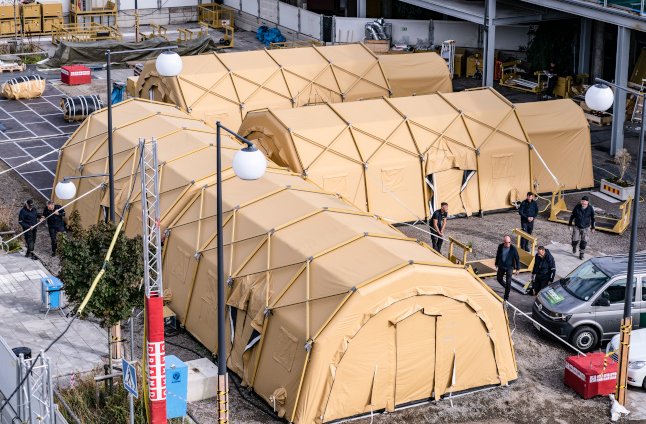
An army field hospital is dismantled in Helsingborg in September. Photo: Johan Nilsson/TT
October: 172 reported deaths
October 1st: Visits at care homes for the elderly are allowed again. Up until now, they have been banned although exceptions have been allowed in cases where it has been possible to reduce the risk of infection, such as having outdoor visits or using plastic screens.
Also from this date, it becomes possible for a doctor to order household contacts of people with Covid-19 to stay at home. The goal of this is to make it easier for people to work from home or be granted disease carrier's allowance if they are symptom-free but share a household with someone with Covid-19.
October 20th: The first set of regional coronavirus recommendations are introduced, in Uppsala, after this became a possibility the previous day. Up until now, Sweden has focused on national recommendations that rely on individuals taking responsibility and adapting their actions to their personal context, and the agency has said that systems of tiers and zones as in other countries risk causing confusion.
In Uppsala, residents are urged to avoid physical contact (defined as being closer than 1.5 metres) with people they don't live with; and to avoid bars, restaurants, shopping centres and gyms.
October 22nd: The special recommendations for over-70s are scrapped. Since March, people in this group have been urged to isolate completely and avoid all situations with risk of crowding including grocery shopping.
October 27th-29th: Regional recommendations are introduced in Skåne, Stockholm, Östergötland and Västra Götaland. They are largely the same as those in Uppsala, but there are some small differences between the regions, with some avoiding against non-essential use of public transport for example and others not.
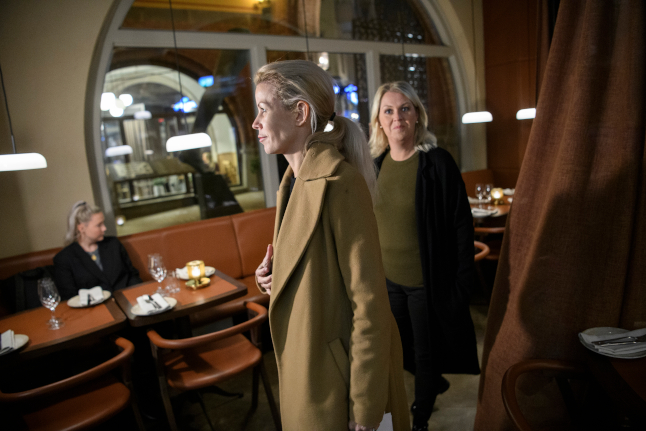 Stockholm Mayor Anna König Jerlmyr and Health Minister Lena Hallengren join an inspection of restaurants in the Swedish capital. Photo: Henrik Montgomery/TT
Stockholm Mayor Anna König Jerlmyr and Health Minister Lena Hallengren join an inspection of restaurants in the Swedish capital. Photo: Henrik Montgomery/TT
November: 1,123 reported deaths
November 1st: The limit for public events is raised from 50 people to 300 in certain situations – when attendees are seated and distance between them can be ensured. The regions with local coronavirus recommendations say they will not introduce the change however. This decision has been postponed for several weeks amid the uncertainty of the situation.
November 3rd: The government announces that no more than eight people will be allowed per group in bars and restaurants.
November 3rd-16th: The Public Health Agency introduces regional recommendations in Sweden's remaining regions except two. The exceptions are Blekinge, where regional authorities introduce their own measures instead, and Jämtland.
November 16th: In possible the strictest coronavirus rule change to date, the government limits public gatherings to no more than eight people. Prime Minister Stefan Löfven says this should be seen as “the new norm” even for private events, and urges people to stick within 'bubbles' of no more than eight people, although the Public Health Agency refuses to put a number on its recommendation that people should only socialise “with a smaller circle” of people.
November 18th: The World Health Organisation said “masks work” in response to a question about whether recommending mask-wearing would be a useful addition to the Swedish strategy, but stopped short of saying Sweden should introduce such a recommendation.
November 20th: A ban on post-10pm alcohol sales at pubs and restaurants comes into effect.
November 22nd: Prime Minister Stefan Löfven holds his second televised speech, this time with a much stronger tone. He says: “The things we do wrong now as a country, we will suffer for later. The things we do right, will give us joy later. What we do now will affect what our Lucia celebrations will look like. What Christmas celebrations will look like. Who will still be there with us this Christmas. It may sound harsh. It may sound brutal. But reality is exactly that harsh and brutal.”
November 24th: The 'local' coronavirus recommendations now apply in all Sweden's 21 regions and are extended until December 13th.

People light candles at a cemetery in Malmö on All Hallow's Eve. Photo: Johan Nilsson/TT
December: 2,515 reported deaths
December 1st: The Public Health Agency changes its recommendations so that even preschool children who live with someone with confirmed Covid-19 should be kept at home
December 7th: Upper secondary schools switch to distance learning again for the rest of the term, and the Public Health Agency makes it possible to introduce local visiting bans at care homes for the elderly.
December 14th: New national recommendations replace the local coronavirus measures, and these are slightly more strongly worded than previously (the verb changes from 'bör' or 'should' to 'ska' or 'shall'). These include limiting gatherings to a small number (the government states no more than eight, but the Public Health Agency doesn't give a number) and limiting travel.
Recommendations to work from home if possible are extended to the end of June 2021.
The Civil Contingencies Agency sends a mass SMS to millions of mobile phones in the country warning people to follow the new recommendations and look at the Krisinformation website.
December 15th: The coronavirus commission's first report is published, with harsh criticism aimed at the government, Public Health Agency, regions and municipalities. Sweden failed to protect its elderly, the report confirms, and states that the ultimate responsibility for the failure lies with the current and previous governments.
December 18th: The government announces new, stricter restrictions to apply from Christmas Eve: a ban on post-8pm alcohol sales (previously 10pm). a limit of four people per group in restaurants (previously eight), and upper secondary schools must continue distance learning until January 24th. Shops and businesses must set a limit on the maximum number of people allowed inside simultaneously.
Additionally, face masks – which until now have not been recommended at all apart from within the healthcare sector to be worn by healthcare and care staff – will be recommended from January 7th on public transport, although only between 7-9am and 4-6pm.
December 21st: After a new, possibly more contagious variant of the coronavirus is reported in the UK, Sweden introduces an entry ban on travel from the UK and Denmark, and stops all flights from the UK for two days, which is later extended until December 31st. To begin with, even Swedish residents are banned from entering Sweden from the UK if they are not Swedish citizens, but this decision is reversed two days later.
December 26th: The first case of the variant first discovered in the UK, B117, is reported in Sweden.
December 27th: The first person in Sweden, 91-year-old Gun-Britt Johnsson, receives a coronavirus vaccine. Earlier in the month, Sweden pledged that everyone aged over 18 in Sweden will be offered the coronavirus vaccine before Midsummer 2021.
December 28th: According to Public Health Agency data on January 28th, this was the deadliest day of the pandemic, with 121 deaths linked to the coronavirus.
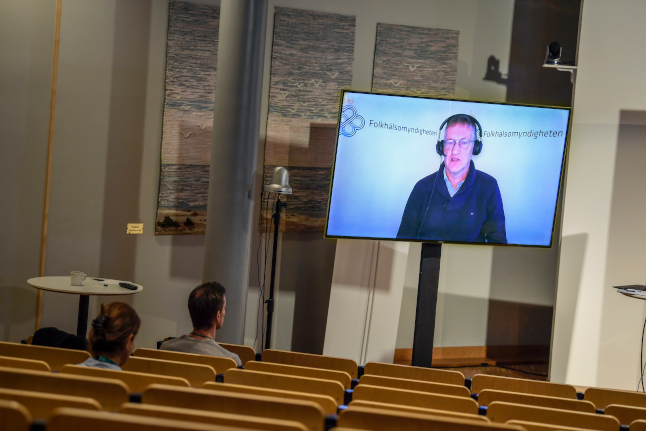
The Public Health Agency's press conferences move online in December. Photo: Pontus Lundahl/TT
January 2021
January 7th: The government says for the first time in the pandemic that lower secondary schools (for 13-15-year-olds) may bring in distance learning for the spring term, after this was previously only allowed in certain specific situations.
January 8th: A new temporary pandemic law is passed by the government after being rushed through, with parliament recalled early from their Christmas recess. Now the government can make fast decisions on things like limited opening times or maximum number of people in shops and businesses, as well as introduce closures. The main difference from last April's law is the option to introduce more moderate measures, like limiting opening times, rather than closing businesses altogether.
January 11th: The pandemic law comes into force. This includes a new law limiting visitors to shops, gyms and public pools, among other places, to a maximum of one person per ten square metres. Venues in violation of these rules may be handed fines.
January 14th: Sweden's coronavirus death toll passes 10,000.
January 21st: Upper secondary schools get the option to carry out some teaching in person.
January 22nd: Travellers from South Africa and Brazil to Sweden are asked to isolate on arrival and get tested for the coronavirus, after new variants are discovered in both countries. A general travel ban is still in place for most non-EU countries, including these two, but various exceptions apply including for Swedish and EU citizens.
January 24th: Sweden bans travel from Norway following an outbreak of the variant first found in the UK.
January 26th: More than 95 cases of the new virus variant, B117, have been found in Sweden, almost a third with no clear link to travel.
January 29th: The Public Health Agency asks the government to introduce a requirement for foreign nationals to show a negative Covid-19 test no more than 48 hours old before entering Sweden.

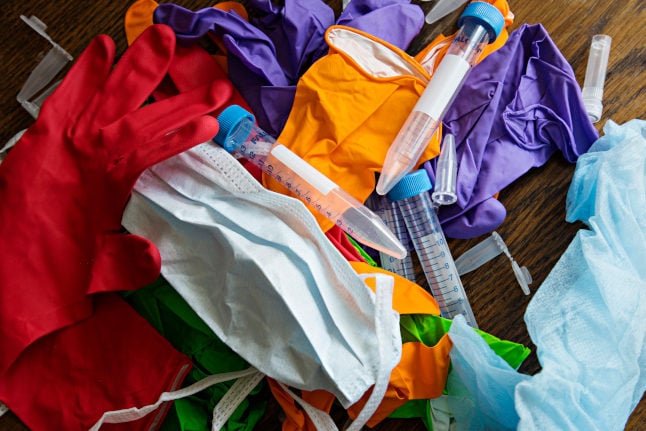
 Please whitelist us to continue reading.
Please whitelist us to continue reading.
Member comments